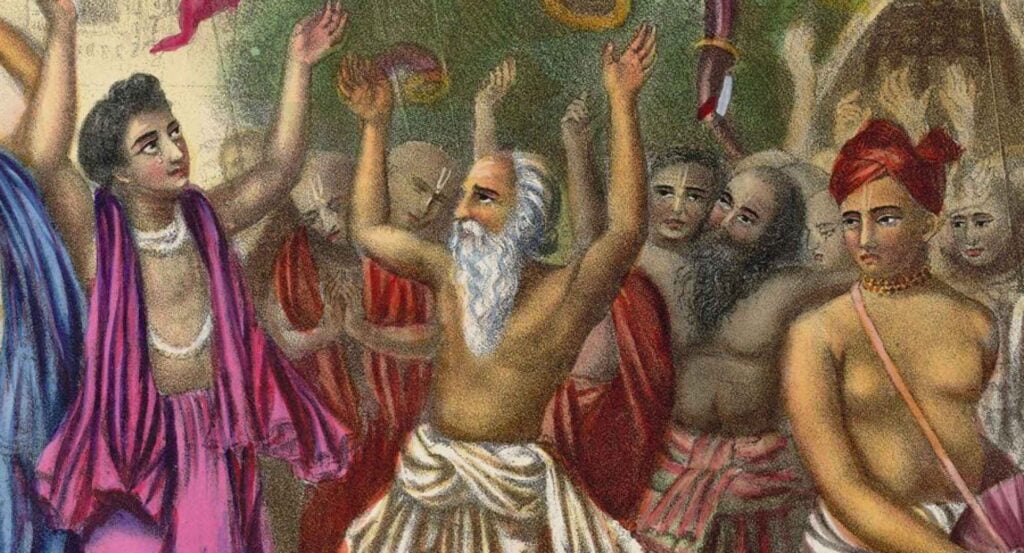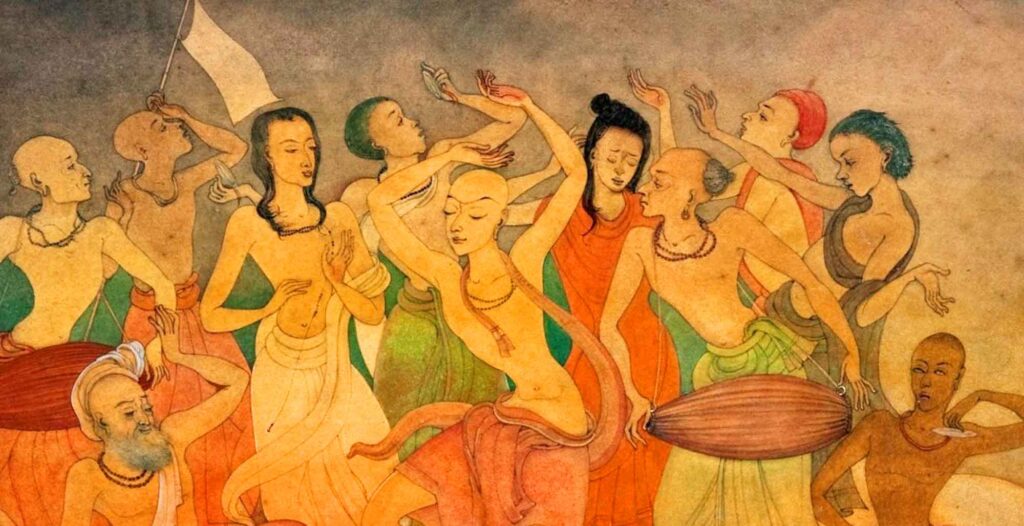Overview
In Vedānta Darśana (The Vedānta Philosophy), published in Sajjana Toṣaṇi, Vol.8, Issue 1 in 1896, Śrīla Bhaktivinoda Thākura gives a brief history of the Brahma-sūtras (Vedānta) and explains what is within them.
(translated by Swami B.V. Giri)
We have felt great happiness reading Vedānta-Darśana edited by Śrīyuta Kṛṣṇa Gopala Bhakta. This book, otherwise known as uttara-mīmāmsā or brahma-sūtra is composed by Maharṣī Vedavyāsa, and its commentary, the Govinda-bhāṣya has been translated into Bengali by Śrīyuta Śyāmalāl Gosvāmī Siddhānta-vācaspati, who has published a Bengali translation as well as a commentary. All the mahāmahopadhyaya-paṇḍitas of India, who have risen like stars and enlightened the world, have unanimously praised the Brahma-sūtra. Śrīmad Śaṅkarācārya, Śrīmad Rāmānujācārya, etc., and the ācāryas of jñānī and devotional sampradāyas have adopted this Brahma-sūtra to establish their own philosophies; after all, any sampradāya which does not write a commentary on the Brahma-sūtra has no ācāryatva in India.*
*Translators Note: The word ācāryatva denotes that one cannot have any proficiency as a teacher of proper conduct, or dharma.
A description of the Brahma-sūtra would be that the entire Vedānta is present in the form of the Upaniṣads. All the wealth of knowledge is found within the statements of the Upaniṣads, but they are incomprehensible. It is not easy to understand the relationship between the meaning of one statement and that of another, thus it is difficult for a student to come to a precise conclusion by reading the Upaniṣads. The meaning of the Upaniṣads can never enter the heart without the instructions of a sad-guru. Human birth is useless without knowing the meaning of the Upaniṣads. Bhagavān Bādarāyaṇa deliberated upon this topic in his heart and divided the subject matter of the statements of the Upaniṣads and presented them as sūtras – this is called the Brahma-sūtra. Unlike Sāṅkhya, Pātañjala, Nyāya, Vaiśeṣika and Pūrva-mīmāṁsa, the Brahma-sūtra is not only about expertise in argument; but it is worshiped by all as the most decisive Āryan text that determines the true meaning of the Vedas. Those who wish to acquire true tattva-jñāna (knowledge of the Absolute Truth) study the Brahma-sūtra without having to labour hard in the study of other śāstra.
Gathering the meaning of the Brahma-sūtra is not easy for the jīvas, because if one directly reads the sūtras, the meaning is not clear. The sūtras cannot be understood without a commentary, or if one can learn the meaning of the sūtras from a sad-guru in order to achieve tattva-jñāna, the difficulty remains in finding the correct commentary to the sūtras or finding a sad-guru who can ascertain their meaning. Bodhāyana Ṛṣi composed a commentary to the Brahma-sūtra, and that was almost unavailable. After great endeavour, Śrī Rāmānuja Svāmī collected this commentary from Sāradā Pīṭha and then wrote his Śrībhāṣya – this has been seen in the Sanskrit text Prapannāmṛta. Sāradā Pīṭha is a particular place of Śrī Śaṅkarācārya. Can there be any doubt that Śaṅkara Svāmī preserved this commentary of Bodhāyana in his maṭha with great care? Śaṅkara Svāmī is directly an avatāra of Rudra, and to fulfill his duty, he wrote his own Śārīraka-bhāṣya, and it is rumoured that he kept the commentary of Bodhāyana hidden in order to increase the circulation of his own commentary.
Vedavyāsa is the composer of the Brahma-sūtra. After composing all the sūtras, he decided that, “The reason that I compiled the sūtras by drawing from the Upaniṣads has not been successful.” When he revealed the Śrīmad Bhāgavata on the instruction of Śrī Nārada, then at at that time, he endeavoured to also reveal the meaning of the sūtras. Thus, Vyāsadeva formulated the Śrīmad Bhāgavata as a commentary to the Brahma-sūtras, which has been narrated in various Purāṇas.
Although the mahā-purāṇa Śrīmad Bhāgavata is certainly an authentic commentary on the Brahma–sūtras, Bodhāyana Ṛṣi prepared a formal commentary at the behest of his guru. Thus there are two commentaries on the Brahma-sūtra existing in the world. Śaṅkara Svāmī, to fulfill his duty and on the instruction of Bhagavān, composed a māyāvāda commentary and tried to keep both the aforementioned commentaries hidden. *
*Translators Note: This refers to both Bodhāyana Ṛṣi’s commentary and the Śrīmad Bhāgavatam.
While Śrī Rāmānuja, the avatāra of Saṅkarṣaṇa, was collecting the commentary of Bodhāyana, the Śrīmad Bhāgavata was already preaching the message of his Śrī-bhāṣya to the world, and giving the true meaning of the sūtras. Śrīmad Govindadeva instructed Śrī Baladeva Vidyābhūṣaṇa to present to the sādhus that sweet rasāśrita-tattva (the divine reality taking refuge in rasa) that could not be known from the Śrī-bhāṣya. This Govinda-bhāṣya appeared in the province of Jaipur through Baladeva, a scholar of all the Vedas who had taken shelter at the feet of Śrī Caitanyadeva. Can one doubt that the Śrīmad Govinda-bhāṣya is the most excellent amongst all other commentaries? Whatever paṇḍitas that are corrupted by māyāvāda may say, it is no exaggeration to state that there is no other text as honourable in the congregation of devotees as the Govinda-bhāṣya.
The Brahma-sūtra is divided into four chapters. Each chapter has four pādas (sections). Baladeva writes at the beginning of his commentary –
tatra prathame lakṣaṇe sarveṣāṁ vedānāṁ brahmaṇi samanvayaḥ | dvitīye sarva-śāstrāvirodhaḥ | tṛtīye brahmāpti-sādhanāni | caturthe tu tad-āptiḥ phalam iti | yatra niṣkāma-dharma-nirmala-cittaḥ sat-prasaṅga-lubdhaḥ śraddhāluḥ śānty-ādimān adhikārī | sambandho vācya-vācaka-bhāvaḥ | viṣayo niravadyo viśuddhānanta-guṇa-gaṇo’cintyānanta-śaktiḥ sac-cid-ānandaḥ puruṣottamaḥ | prayojanaṁ tv aśeṣa-doṣa-vināśa-puraḥsaras tat-sākṣātkāra ity upari spaṣṭaṁ bhāvi | yasyāṁ khalu viṣaya-saṁśaya-pūrvapakṣa-siddhānta-saṅgati-bhedāt pañca nyāyāṅgāni bhavanti | nyāyo’dhikaraṇāt | viṣayo vicāra-yoga-vākyam | saṅgatir iha śāstrādi-viṣayatayā bahu-vidhā’pi na vitāyate
Śrīyuta Śyāmalāl Gosvāmī Prabhu has translated it in this way –
In the first chapter of the Brahma-sūtra it explains that all the Vedas are reconciled in Brahman. In the second it shows that this is not contrary to all the śāstra. In the third it describes the sādhana to attain Brahman. In the fourth it is stated how the attainment of Brahman is the only ultimate goal of human life (puruṣārtha). A jīva who is by nature desireless, pure in heart, who has greed to associate with holy persons, who has śraddhā, who is endowed with such qualities as peacefulness, compassion etc. is a qualified person to study this śāstra. This śāstra is itself the vācaka (description) and Brahman is the vācya (described), thus there is a mutual sambandha (relationship) between both vācya and vācaka. The viṣaya (subject) discussed by this śāstra is the Supreme Person, Śrī Kṛṣṇa who is faultless, endowed with transcendentally pure and unlimited qualities, who possesses inconceivable blissful śaktis and is comprised of eternity, knowledge and bliss. The prayojana (aim) is to directly realise Him after having destroyed unlimited faults. In this śāstra there are five parts – viṣaya (subject matter), saṁśaya (doubt), pūrvapakṣa (objection), siddhānta (conclusion), and saṅgati (reconciliation consistent with śāstra). Adhikaraṇa means the name of a particular part of the chapter. The section meant for discussion is called viṣaya. When there are various conflicting meanings regarding the nature of something, that is called saṁśaya. Opposition is called pūrvapakṣa. An agreement on the meaning according to evidence is known as siddhānta. The presentation of subsequent meanings is called saṅgati. This saṅgati is of various kinds, but this has not been explained due to fear of redundancy; It will be self-explanatory in certain places in the course of this śāstra.
The respected readers of this book will see how beautiful this commentary on the sūtras is, and moreover, how the Gosvāmī’s translation is so clear and faultless. Therefore, as it is a particular advantage to the Vaiṣṇava world, everyone should try to get this book. Many people think, “I am a Vaiṣṇava,” but one should study the Śrī Govinda-bhāṣya to know exactly what one must do and understand, in order to become a Vaiṣṇava. This Govinda-bhāṣya is a priceless treasure for the Vaiṣṇavas,













